Vehicle Incarnations
The Tomato Years 1996-1998
Dung Ho 1999
Running Mate 2000
Monafly 2001-2002
Time Flies 2003-2004
Anemone of the State 2005
Whirled Cup 2006
Return of the Tomato 2007
or, now for something completely different…
|
|
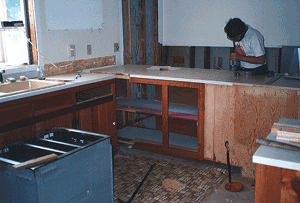 |
|||
| Weird Wheels v Kitchen | ||||
| If you caught the Canadian broadcast (on LifeNetwork) Weird Wheels, you saw Running Mate's antics in Port Townsend. You saw the craziness of PT's judges and learned that Bob's crew is not alone in their kinetic endeavors. You also learned that Bob has been avoiding the kitchen remodeling. As proof of the destruction, see photo at right. | Weird Wheels broadcasts on Discovery Home and Leisure sometime in 2001.
Yaletown Entertainment filmed 13 episodes of Weird Wheels and the Port Townsend race was one of those episodes. |
|||
| Hunting for the Leak | ||||
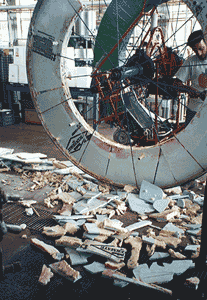 |
If you've followed the success and failures of this vehicle, you are very much aware that flotation is no longer a feature it boasts.
Simple attempts to patch the suspected source of the leak failed. This left only one option—strip off all the styrofoam and start over. At the left, Bob begins the messy, tedious, and downright not very fun job of removing the laminated sheets of blue foam. Several weekends later, Bob and Sherry managed to remove all the original foam, ground away rusty parts, and pounded out a few dents. The last time the vehicle looked like this was 1996. |
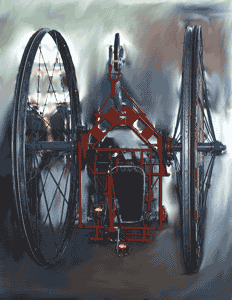 |
||
| The Making of a Torus (doughnut) | ||||
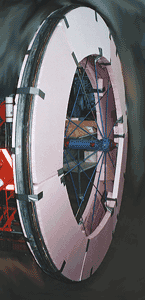 |
Much was learned from the original work with styrofoam. This time, Bob decided to abandon the laminated foam sheets in favor of the application of commercial-grade spray foam.
To contain the spray foam (it expands as it cures), foam tori needed to be constructed. At the right, you see one torus. Leftover foam pieces were used to provide support at each seam. Each torus is made of 6 sections, cut to match the diameter and arc of 8' wheels. At left, two tori are held in place with none other than duct tape. Two-inch pink foam sheets were used to construct the tori. |
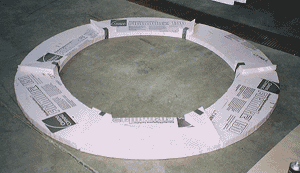 |
||
| Foam Sandwich | <Return to Top> | |||
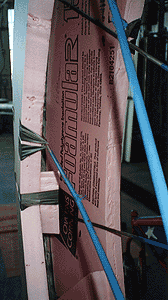 |
A talented spray foam applicator is crucial for success. Bob was fortunate to have access to such a person at Spray Foam, Inc. in Albany, OR.
The cavity at the left was gradually filled with expanding spray foam. The depth is 16" and tapers from 7" at the inner most ring to 3" at the rim. The spokes were inside the pink tori. This would increase flotation, at least on paper, so that even with a mud load, the vehicle and its artwork would be stable and stay afloat. The new foam adhered to the pink tori and created a very solid foam core. This chore, we should mention, was done with one week to spare. |
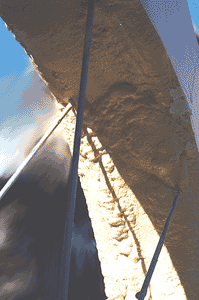 |
||
| Functional But Ugly | ||||
| Duct tape and 2" foam is not a match for the pressures created by the expanding foam. As you can see in the photo, at right, every weak joint and crevise was consumed by the spray foam. In truth, this is good. This means that unlike the original flotation of years past, there should be no air spaces that could fill with water/mud and cause the vehicle to list and become unstable. | With one week before the race, the cleanup seemed a daunting task. Edges needed to be trimmed, smoothed, and prepped for painting. Tools included hot wire, sander, razor knives, and face masks.
In addition, plastic pot scrubbers were needed to clean off the excess spray particles that coated the frame, disk brakes, gears, chains, seat, pedals—everything! |
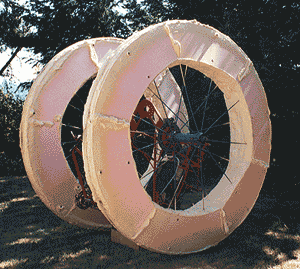 |
||
| The Butterfly | <Return to Top> | |||
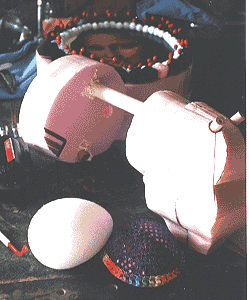 |
When not stripping foam off the wheels, prepping new foam, we were not idle.
There was the matter of a large (10' wingspan) butterfly to make. The inspiration came from a presentation by Bill Burbach at one of the Kinetic Workshops. Bill works with folks such as Michael Curry in the design and making of huge, animated puppets. Sherry wanted to work with fabric and a giant butterfly offered her a challenge. The body of the butterfly needed to be light. The weight of the ostrich from Running Mate taught Bob that much. So styrofoam was minimized (at left) to be covered by lightweight fabric. At right, Bob mills holes in PVC pipe that will become butterfly support. |
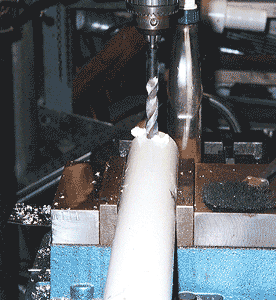 |
||
| Something is Still Missing | ||||
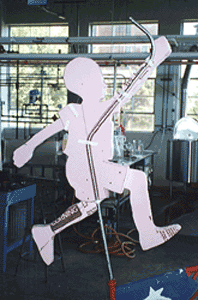 |
New floation…check!
Large butterfly…check! Animated butterfly…check! Flicking proboscis…check! Reason for butterfly…uhhhhh. Clearly we needed a reason to have a butterfly… "In the real world, what do you associate with butterflies?" "Nets." "Who uses the nets?" "Kids." Hence, Andi was created and designed to sit atop the third wheel. |
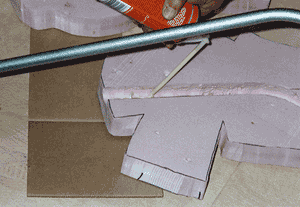 |
||
| Andi Supervises Painting | <Return to Top> | |||
| Andi was based on a tracing of a friend's six years old daughter. Our paper tracing of Andi was then used as a pattern from which we cut body, arms, and legs in 2" pink foam remnants.
Using a hot wire and sharp knife, Andi was re-sized to fit into a set of used kids clothes from a local second-hand store. Her net was made from iridized white mesh fabric and affixed to the handle of net that was missing the net. Her hair was cut from brown yarn and carefully attached using hot glue. She was painted the same color as our house—red-brown and this gave her a nice bronze tan. We didn't put a face on her, her hat mostly covered her face, anyway. Shoes are fabric and rick-rack hot glued into place. Stiffened fabric butterflies were glued onto her hat. |
With only days remaining before the race, pit crew members were starting to arrive and were eager to lend their expertise in getting Monafly race-worthy. Gabi Carey adds her artistic touch by painting veins on the leaves (sepals). | 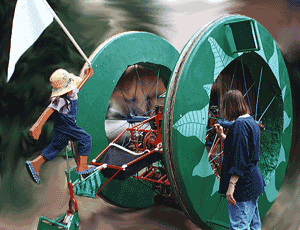 |
||
| Finishing Touches | ||||
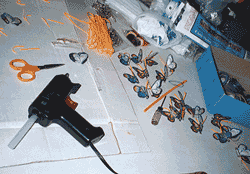 |
Bribes, in the form of stiffened fabric butterflies were worked on when it was too dark to paint outside. Fabric stiffener was applied to cut-out butterflies (individually cut from a yard of fabric) and they were dried over the corner of 2x4s that were covered with wax paper. Antennae (cut from plastic lanyard) and pin backs were fastened to the butterflies with hot glue.
Plastic grass was attached (spray foam) to the flotation for the third wheel. Two years ago, this was Dung Ho's beetle head. |
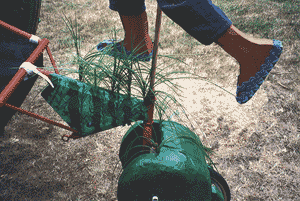 |
||
| da Vinci Days 2001 | <Return to Top> | |||
| Who would have thought that a one-pilot vehicle would need so many pit crew members? Is Bob that helpless? Is Monafly that unreliable? Are these people willing to do anything to earn a team t-shirt?
Shown here (left to right) are Gabi, Peter, Michael, and Dwight (Bob's CalTech classmate) Carey; Barb (Bob's sister, front row) Hargand; Sherry (Bob's wife); Bob (the pilot and builder); and Kerry (Bob's long-time friend, and co-builder) Montgomery. Monafly's wings are in the "folded" position in this photo. The wings are fashioned from black, rip-stop nylon (The Rain Shed is a great resource). Lightweight orange cotton and iridescent white (100% polyester) make up the coloration of the wings. The white was affixed to the rip-stop using double-sided fusing. The orange was sewn onto the nylon. The pattern was created by enlarging a photo of a monarch butterfly onto paper. |
The stiffness of the wings was accomplished by using fishing poles (seconds from Lamiglass). Bob milled attachment pieces to hold two fishing rods per wing (4 total). The antennae are made from carbon-fiber rod (it is very lightweight) to which styrofoam eggs were attached to form the club ends.
The body (see assembly above) is covered with lightweight polyester fabric that looked hairy. The total weight of the butterfly (wings and body) is under 7 lbs. This was a vast improvement over the ostrich of Running Mate which weighed 25–30 lbs.! Thanks again to Bill Burbach for his sound and creative advice. The team won Committee's Choice Award on the first day of the race. $50 in da Vinci food court script was enjoyed by the entire team. |
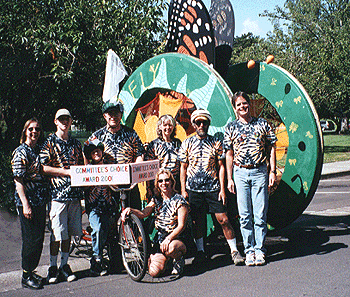 |
||
| Day two: Safety Check and Road Race | ||||
| The first day of da Vinci Days consists of art and pageantry judging, meeting racers, and hot gluing last minute details.
The second day includes a safety check. You must have various items on board and demonstrate that you and your vehicle can start, stop, float, etc. Next comes the parade through town and campus. The parade is followed by a brief respite and then the race begins. The course is about 8 miles and includes a sand dune and hilly terrain. At right, the scissor jack contraption that lifts the butterfly above the wheels and opens the wings simultaneously, can be seen. |
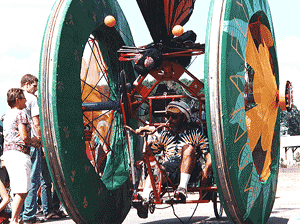 |
|||
| Monafly Hits the Road | <Return to Top> | |||
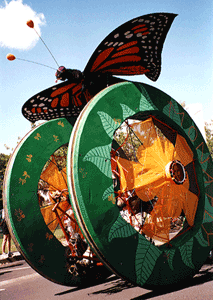 |
Monafly (a blend of Mona Lisa and Monarch butterfly) was a crowd pleaser. The animation of the butterfly (shown at left with opened wings) brought cheers and "Wows" from spectators. The proboscis would unfurl when Bob blew into a tube. This brought laughs.
The "flower" covering over the wheels was made by reusing red netting last seen on one of the Tomato versions. This time, yellow, macromesh (The Rain Shed) was sewn on the older red netting. The center of each flower included a life-size face of, who else, Mona Lisa. The rim of this piece was decorated with leftover Tomato, Dung Ho, and Running Mate notions. Andi warmed everyone's heart. |
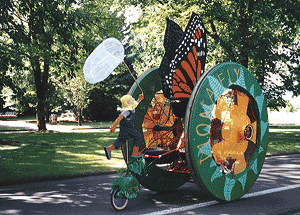 |
||
| Andi Shows Determination | ||||
| Part of the road race takes place in a farmer's freshly cut hay field. It was a perfect place to watch Andi continue her chase of Monafly. | 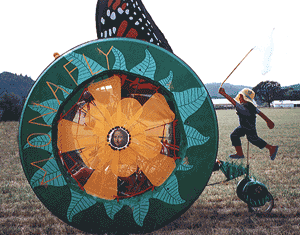 |
|||
| Sand Dune | ||||
| The third wheel, assisted by Andi, has made conquering the sand dune very easy. Gone are the days when Bob had to "throw" his weight out onto those handlebars in front. | 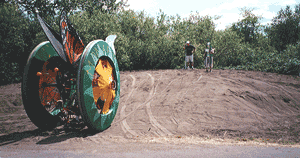 |
|||
| Day Three: The Mud Bog | <Return to Top> | |||
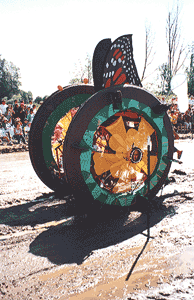 |
Barb, Peter, and Dwight (at right) check out the viscosity of the mud bog.
The wild, tie-dyed t-shirts were purchased from Sarah's shop (Expertees). The mud proved to be doable for Bob. However, he had to go out on the handlebars a couple of times. It was deep and sticky in that bog. Some vehicles had to be towed out by their pit crew or mud-happy spectators. |
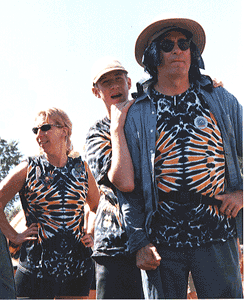 |
||
| Despite the little extra flotation, we didn't want to risk letting the added weight of thick mud on the wheels hinder the float down the Willamette River. So, dedicated pit crew assist Bob by giving Monafly a bath at the river's put-in.
This bath took place while a few vehicles were still struggling to get to the other side of the nearby mud bog. An added advantage this bath offered was to let Bob (for the first time) try out the flotation of the new, improved wheels. Next time, we'll plan better and bring brushes. The sandy, rocky mud was a bit rough on the hands. |
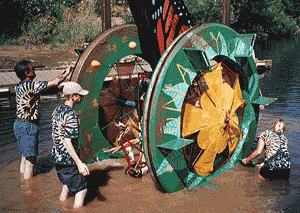 |
|||
| Floating Down the Willamette River | ||||
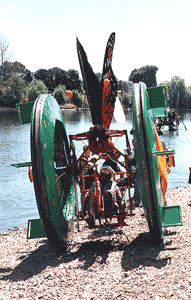 |
Andi (at right) dons a life jacket for the river run of the final day of the race. This, too, was well received by judges and spectators.
This portion of the race is about a mile downstream. Monafly was stable and floated level. Hooray! Bob exited the river with no problems. |
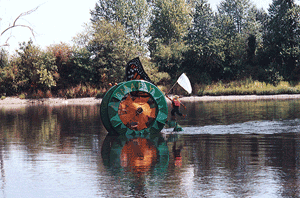 |
||
| <Return to Top> | ||||
© 2001 by S. Clark